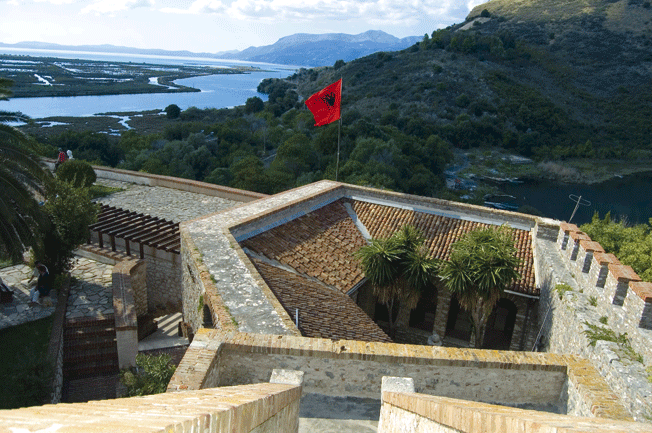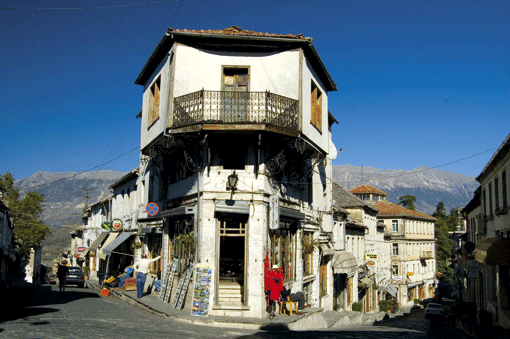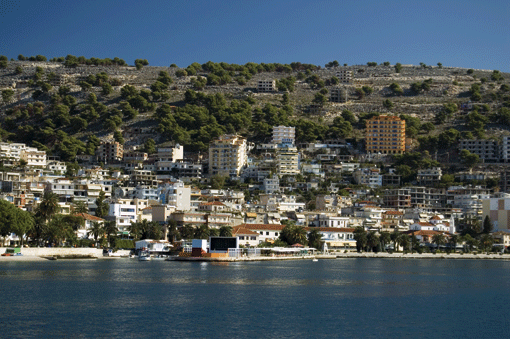
Travel
Albanian Adventure
Day Trip from
Corfu to Saranda

By: Veronica Maria Garbutt
Until recently a closed country, Albania is now open for business. What better way to get a glimpse of this intriguing land than by taking a quick and easy day trip to the Ionian Sea on from the Greek island of Corfu. Sipping local apple tea, aboard the Petrakis hydrofoil Flying Dolphin during the 40 minute journey, I marvelled at the mysterious Albanian shoreline as the Greek islands disappeared from view.
Nestling beneath a backdrop of mountains the ancient city of Saranda has a setting that would be the envy of many a Mediterranean resort. Ancient Onchesmos, as the port was formerly known, is built with old whitewashed houses around a horseshoe bay. It was first settled by the Chaonians, an Illyrian Tribe, and Cicero mentions it as a favourable harbour with a prevailing wind. Mosaics from the 2nd and 3rd centuries CE have been found in the town along with a semi-circular wall from the 4th century.
The town acquired its current name at the beginning of the 20th century. Since a market economy was introduced, several new buildings have sprung up too. The town has long been a resort area as it boasts almost 300 sunny days a year with temperatures rarely above 30°C. Strolling around town, drinking coffee and eating fresh fish beside the sea seem to be the most popular activities on offer, and the town is a useful base for exploring the south-west of the country.
After clearing immigration (visas are no longer required for many nationalities) we board a waiting bus and set off to explore the UNESCO World Heritage Site at Butrint. Over the centuries this ancient town had disappeared under layers of silt and vegetation, but archaeologists have discovered some of the best remains of a Mediterranean working town. The ruins are found in an exquisite natural lakeside setting, part of a 29 sq. km national park.
In classical mythology, what was known as Buthrotum was supposed to have been founded by settlers from Troy. It was referred to by Virgil in the Aeneid. ‘Soon were the lofty peaks of Corcyra lost to view: We [i.e Aeneas and his companions] coasted along Epirus, and coming to the Chaonian Harbour we drew near Buthrothum, that hillcity’. The ancient legend revived by Teucer of Cyzieus, claims that having arrived at this site from Troy, Priam’s son Helenus sacrificed an ox to ensure his safe entry to Epirus. The wounded ox plunged into the sea, swam into a bay and then landed on a beach where it fell and died. Helenus took this as an omen and he called the place Buthrotos, meaning ‘the wounded ox’.
Butrint became an important Roman town after the conquest and the break up of the Epirote League, and it was spared the destruction meted out to most of the 70 other cities of Epirus. In this period it increasingly over-shadowed Phoinike. In the time of Julius Caesar and Augustus it was a naval station and grain depot for Julius Caesar’s army. About 10th century BCE the main aqueduct bringing water to the city from the Xara springs, was built. The aqueduct was about 3km long and is depicted on Roman coins dating from the time of Augustus and Nero. Butrint is mentioned frequently in the letters of Cicero who, in a letter to Atticus, compared it with Antium. In the 4th century the city walls were rebuilt. By then it enclosed a substantial town covering 11 hectares with a theatre and market building.
About the middle of the 10th Century CE the area was mentioned in the guide for medieval merchants written by the Arab chronicler, Al-Idriz, as a prosperous small city with a market and many shops. In 1204 it became part of the Despotate of Epirus. A separate fortress, away from the central acropolis was built in this period. Further fortifications were built by the Venetians, who maintained an important naval station at the mouth of the river for over three hundred years. It was taken over by the Turks, and then by Ali Pasha. The Ottoman ruler constructed a fort by the river estuary mouth. During the Napolonic War this was occupied briefly by the French under the Treaty of Campo Formio in 1797.
As we enter the site, first up is the 3rd century BCE Greek theatre secluded in a forest below the acropolis. Nearby are the public baths, a Venetian tower and a section of the wall dating from the 4th century CE. We climb up the acropolis with its square Turkish castle and explore the museum within. The far end of the acropolis, where the Venetian and Turkish cannon remain in position on the walls, is laid out as almond tree filled gardens around the fort. The view from the top can be described as tantalising and helps make sense of the site in a way that no map can.
Leaving Butrint we make our way to Palma, a seafront restaurant in Saranda, for lunch. A sumptuous buffet awaits us and, as you would expect, fish and seafood are prominent along with local mussels, farmed in Butrint. Grilled meat, meat balls and mutton with yogurt remind me of Turkey, but can be found all across the Balkan apparently, along with plump olives and goats cheese, sliced tomatoes, cucumbers and grilled aubergine. For dessert there is delicious akullore (fresh ice cream). It is indeed a feast fit enough to set before a king, no less!
Time now for our group to return to the ferry port and back to Corfu. However, so intrigued am I by this unusual land that I arrange to stay on for a couple of nights to explore the area. Hotel Butrinti, overlooking the bay, is my hostelry of choice. I set off to explore the palm-lined promenade and beach, a good place for an early evening stroll. Swimming is possible from the town beach, I’m told, but if it is a day at the beach you are after, it is better to head south to Kisamili or north to the Albanian Riviera.
Next morning it is time to head to fabled Gjirokastra, an austere and beautiful town with UNESCO World Heritage Site status. From its mountain perch this ‘city of a thousand steps’ watches over the Drinos valley below. It lies about two hours’ drive from Saranda by bus and three or four services run each morning from the bus station. You can easily hop on another bus or minibus to return.
Although originally an Illyrian settlement with a connection with the Argyrot tribe, Gjirokastra also has a legendary origin, it being said that it was founded by a Greek princess called Argyros. In early antiquity the city site was almost certainly inhabited, but the area was dominated by the Illyrian city of Antigonea, on the opposite hillside of Jerma, near the modern village of Saraqinshta. Later Roman artefacts have been found in the vicinity. But then for many centuries Gjirokastra was wreathed in mystery and the city is not mentioned in written documents until 1336, when it was described by the Byzantine chronicler Kanatakuzenos as a stronghold of the Zenebish family.
In 1417 it was seized by the Turks and remained an important centre of Ottoman power and administration for hundreds of years, becoming the centre of the Sandjak of south Albania. Fiscal registers for the years 1431-32 show that it then had about 160 dwelling houses. It grew in size considerably in the 16th century, spreading outside the city walls. In 1812 it fell into the hands of Ali Pasha of Tepelena who held it for some time. After he was displaced by the forces of the Sublime Porte, the city became a centre of administration rather than of trade until the end of the 19th century.
During a rising in 1847 the peasants of the Drinos valley occupied the town but were unable to take the citadel and were defeated by the Ottoman troops. A period of instability followed with fighting between Greeks and Albanians until annexation by Italy in 1914. During World War II the city was a centre of Axis administration, and was freed by Albanian partisans and Greek troops in 1943.
Gjirokastra’s architecture and haunting atmosphere are described by one of the city’s most famous sons, Ismail Kadare:
It was a surprising city, which seemed to have emerged unexpectedly from the valley on a winter’s night, like some prehistoric being, clambering up with great effort and stitching itself on to the side of the mountain. Everything in this city was old and made of stone, from the streets and fountains right up to the roofs of its large houses, a century old, which were covered with stone tiles the colour of ash, like so many huge scales. It was hard to believe that under these hard shells the soft flesh of life thrived and was renewed.
The city aroused every traveller who saw it for the first time to make comparisons. But as soon as the traveller fell into the trap, the city hurled the comparison away, because it was a city which was not like anything else. It could not bear comparisons for long, just as it could not bear the rain, hail, rainbows, and multi-coloured foreign flags which came and went above its turrets, as ephemeral and non-existent as the city was timeless and all-embracing.
Kadare, Kronikë në gur (“Chronicle in Stone”), Onufri, 2000
I set off to explore the city which has a unique pattern of Ottoman buildings, particularly the citadel, mosques and 19th century merchants’ houses set. Dominating the town is the 14th century CE fortress, today a museum of armaments. The house where former leader Enver Hoxha was born in 1908 has been rebuilt as an Ethnographic museum. Nearby in the Mechite Quarter, which is full of Ottoman period shops, can be found an 18th century mosque. It is a fine whitewashed structure with a particularly striking minaret. The 19th century dwelling houses of Gjirokastra boast defensively designed tower floors with narrow windows set high up in the walls. The ground floor was usually uninhabited and used for storage. The roofs are of grey stone slates. Most of the neighbourhood with these classic Ottoman residencies encircle the castle. But sadly many of the 400 protected houses have fallen into disrepair as they are fiercely expensive to maintain. One of the best ways of seeing traditional house interiors is to dine at Kerculla Restaurant up the hill, or stay at Hotel Kalemi, down the hill.
The Old Bazaar Quarter is separate from the residential area and most of what can be seen dates from the second part of the 19th century. The standard of craftsmanship in the stonework and woodcarving is high indeed. Popular buys include Albanian flags, bunker shaped ashtrays, slippers and felt caps called qeleshe. In the carpet shops you can watch local women weaving kilim rugs and in the antique shops there are dowry chests, cradles and wooden butter paddles. Gjirokastra is a relaxed bazaar and nobody minds if you just want to browse.
Time now to return to Saranda. But there is just time to stop off at the Blue Eye Spring some 20km south of Gjirokastra. The spring, which is the main source of the River Bistrica, wells from the ground in a pretty glade. It is deep blue in the centre and almost electric blue around the edges, like the pupil of an eye – hence the name. After Saranda I catch the ferry back to Corfu. My day trip became three days – well worth it for a glimpse of the land of rugged grandeur with its severity, beauty and uncompromising spirit.